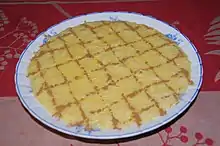Aletria
Aletria (from Arab: al-irtiâ) is a custardy Portuguese dessert based on vermicelli (aletria). In the Beiras region aletria has a compact consistency, and is able to be cut in slices, whereas in Minho its consistency is more creamy.[1]

.jpg.webp)
Origin
Llibre de Sent Soví, a set of two 14th-century manuscripts, in Catalan, contains a compilation of 200 recipes, of which there are two with alatria (170: Qui parla con se cou alatria or "how to cook vermicelli" and 171 : Qui parla con se cou carn ab alatria or "how to cook meat with vermicelli").[2][3] However, what they called vermicelli should have a very different shape from the current thin strands of dough.[4]
Vermicelli was probably brought to the Iberian Peninsula by the Moors in the 8th or 9th century.[5] It remained in Portugal and incorporated into Portuguese cuisine, and began to designate the mass of very fine yarns, with which a typical Christmas candy, present in almost all regions of the country, is prepared. However, over time, the name aletria has disappeared in Spain, remaining only in the region of the ancient Kingdom of Murcia.[6] It is noteworthy that Catalan cuisine has enriched itself a lot with products promoted by the Arabs, including vermicelli.[7]
References
- "Aletria - Um doce com história". Tertúlia de Sabores. Retrieved 28 December 2020.
- "Contents of the 14th c. Catalan Libre De Sent Sovi". Retrieved 28 December 2020.
- "Livres de cuisine médiévale écrits en catalan". oldcook.com. Retrieved 28 December 2020.
- "Pâtes en catalogne". histoiredepates.net. Retrieved 28 December 2020.
- Andrews, Colman (3 December 2005). Catalan Cuisine, Revised Edition: Vivid Flavors From Spain's Mediterranean Coast. Harvard Common Press. ISBN 978-1-55832-329-2. Retrieved 28 December 2020.
- "Canelons i Pasta El PAVO". Retrieved 28 December 2020.
- Prada, Natalia Silva. "El Sent Soví y la alatria". Gastronomía Histórica. Retrieved 28 December 2020.